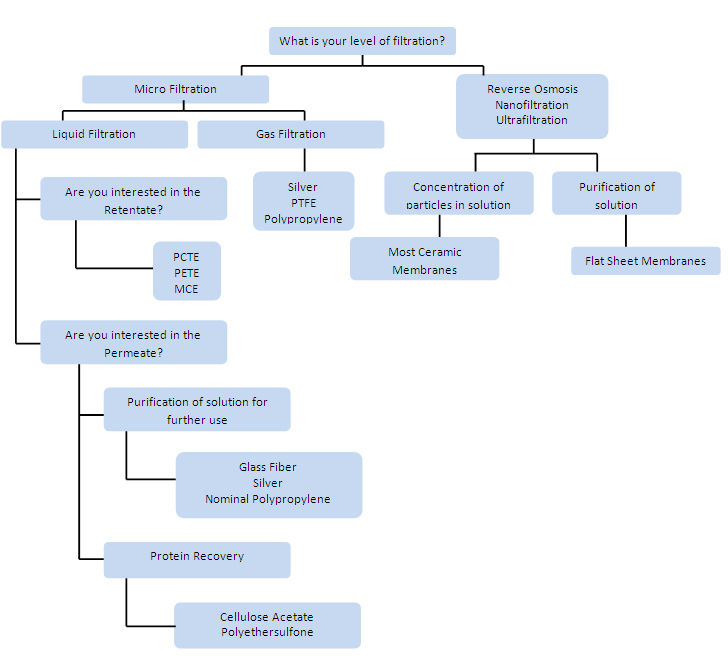Choosing the appropriate filtration membrane
Choosing the Appropriate Filtration Membrane
Things to Consider:
- What is your goal?
- What is the nature of the process fluid?
- What is the volume of the solution being filtered?
- What is the viscosity of the solution?
- What is its protein concentration?
- What is its chemical compatibility?
- What pore size will work best for the solution?
What are you trying to accomplish?
Examine particles that remain on the surface of the membrane?
- Polycarbonate membranes
- Polyester membranes
Filtering solution through the membrane?
Do you want your solution (water) retained by the membrane?
Analyze the permeate?
Other questions to ask yourself:
- What are you filtering?
- Are there particles in the solution?
- If so, how large are the particles? (Allows you to determine the general type of filtration to focus on)
- What is the molecular weight of the material?
- What is the nature and loading of any suspended material?
- What is the pH and temperature of the inflowing stream?
Generally, the various degrees of filtration are broken down like this:
- PF 5.0+ micron
- MF 0.1 - 5.0 micron
- UF 0.01-0.1 micron
- NF, RO 0.001 (theoretical)
What volume of solution are you dealing with?
The following table will help you choose the membrane diameter that will work best with your volume of solution.
| Diameter of Membrane | Volume of Solution |
| 3mm | <1mL |
| 13mm | <5mL |
| 17mm | <12mL |
| 25mm | <100mL |
| 30mm | <120mL |
| 47mm | <1L |
| 99mm+ | >1L |
It should be noted that the use of a pre filter will allow the final filter to tolerate a higher volume because the membrane should be less clogged.
Consider the Viscosity
Solutions with a high viscosity may require a pre-filter
- Helps remove larger & undesirable build-up
- Prolongs life of final filter
- Increases the flow rate
Often used with applications using oils
Commonly used pre-filters include glass fiber, nylon, and polypropylene.
Consider the Protein Concentration
High protein binding membranes such as nylon are used when proteins are to be separated from the solution they are in and retained on the surface of the membrane.
Low protein binding membranes including PES, Cellulose Acetate, and Polypropylene should be used when high recovery of the proteins in the solution is required
Check the chemical compatibility between the membrane and the solution
2 different versions of a chart to check the chemical compatibility can be found here and here.
Determine the correct membrane type

View a chart that shows more detail on choosing the correct membrane type >
Consider Pore Size:
The pore size of a filter, normally stated in micrometers (µm), is determined by the diameter of a particle that is retained by the filter or by a bubble point test.
Pore sizes can be nominal or absolute
In filtration processes where pore size is too small to determine, Molecular weight cut off is used to designate the size of particles rejected from the membrane.
The Filtration Spectrum:
Common Applications for a Given Pore Size:
0.01um - Chemotaxis
- Cytology
- Separation of Samples by size
- Epifluorescence
| 0.03um - Liposome extrusion
- Virus filtration
- Mycoplasma removal
- Bacterial removal
| 0.1um - Sterilization
- Clarification
- HPLC Sample Preparation
| 0.2um - Prefilter
- Microbiological analysis
- Protein, enzyme filtration
- Venting applications
|
0.4um - Sterility testing
- SEM
- Trace metal analysis
| 0.6um - Particle analysis
- Filtration of corrosive solutions
| 0.8um - Removal of RBC from plasma
- Toxicity testing
| 1.0um - Serum prefiltration
- General microfiltration
|
1.2um - Particulate analysis
- Medical Assays
- Immobilizations
| 2.0um - Chemotaxis
- Red Blood Cells
- DNA
| 5.0um - NIOSH Analysis methods
- X-ray diffraction
- Filtration of corrosive solutions
| 8.0um |
10.0um - Large bacteria filtration
- Cancer cell studies
| 12.0um - Metastasis tumor cells
- Schistosoma filtration
| 14.0um - Chemical filtration
- Alcohol filtration
| 20.0um |
View a diagram of the Filtration Spectrum >
